In the acknowledgements to my novel Behind the Locked Door I write: This book had a long gestation period. The idea first occurred to me in 1972, and I began to research in earnest in December of 2010. I first put pen to paper in Zihuatanejo, Mexico, in January 2011.
Let me tell you about how I started to write in Zihuatanejo. I have visited Zihuatanejo for twenty years. Even though I was a little late to the party (Zihuatanejo had already been discovered, see below), Zihuatanejo was quiet and beautiful on my first visit.
I returned many times. I would ride the local bus from Playa de la Ropa where I stayed to the downtown area, Playa Principal. Along the way I noticed a small ensemble of palapas, Villas del Palmar, being constructed. They were located very close to the popular restaurant La Perla.
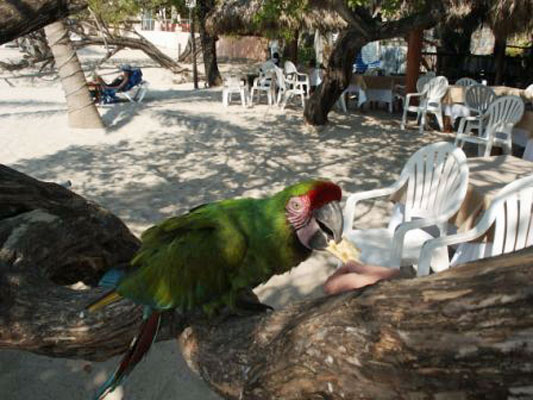
Restaurante La Perla and Parrot
At the end of the workday members of the construction crew would hop on the bus with their machetes and other equipment. They rode with me to downtown. One day I got off at the construction site. I wondered if it might be a good place to stay on future visits. I met the owners, Ruben and Yvonne Gonzalez. Ruben was a mango farmer outside Mexico City. He sold his farm and moved to Zihuatanejo. Villas del Palmar became his new venture. He’s still there. I spent many enjoyable times in his small casual palapas.

Villa del Palmar
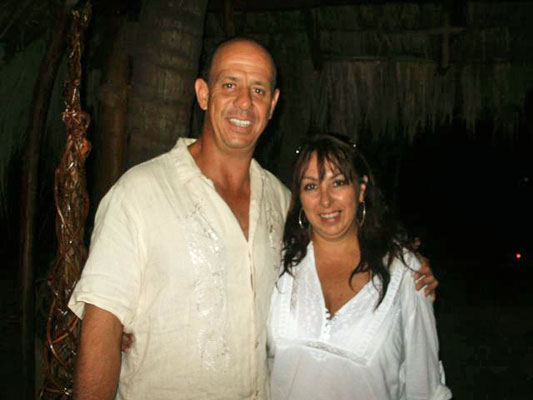
Ruben and Yvonne
One year I sat on the upper level of my palapa and spontaneously begin to write what had been in my head for years.
Confusion. In the shadows, birds sang, scratched, pecked, screeched, went about bird business, and offered a fleeting glimpse of brilliant color. The sound of a car on the road outside, the volume increased as it approached and declined as it sped away like an ocean wave. An ominous insect, big, black, furry, wobbled about in three-dimensional space, a soft wind battled the sun.
Mexico seethed with dark and light. Out on the road, wings flapped. A vulture looked up from a rotten carcass. A raspy hissing sound threatened from its mouth. An iguana sat motionless, sinister, eyes closed on a barren rock, expressed a will outside its own nature, the will of the baking rock itself. Eric closed his eyes. He pursued the dream, searched for peace in a war with death. He walked on the beach and felt the sand. He drank cold juice in makeshift cafes. The sun rose and fell. Death chased him. He stumbled about like Bergman’s Antonius Block, played a chess game with Death. (from Chapter 25: The Appointment)
There have been many revisions over the years. I was in unfamiliar territory but I had to push ahead. I knew I needed help so I reached out to a few friends back in Mendocino who kindly offered comments, ideas, and corrections. Years passed and now the book is at the printer. Here is another passage I wrote in that first go-round.
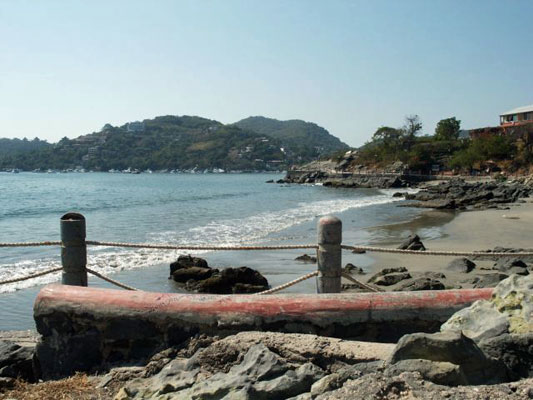
Looking North from Madera Beach
Birds disappear to escape the midday heat. The air radiates up and down like bubbles in a jar. Insects crawl into dark spaces for protection from the sun. Eric sits in a chair shaded by the roof of his palapa. He looks out to the ocean, visible through the palm trees. Nothing moves. The world no longer rotates. The sun is focused on him alone. Of course it’s an illusion. The sun’s rays are impartial. They cover half the world at a time, together with an infinite array of other planetary objects. The sun cares nothing about him or anything else its golden rays might touch. (from Chapter 28 (At the Palapa)

Chachalaca birds
Villas del Palmar consisted then (and still does) of just four two-story palapas. One was occupied full time by an American couple that escaped New York after 9-11. They eventually opened a restaurant. Since I’d been in the business, it was natural that we had numerous discussions. On future trips down I brought supplies that were hard to find in Zihuatanejo (spring pans for their signature lolli-cakes (frozen ice cream similar to cheesecake), peanut butter, Boston Baked beans, pizza making equipment and so on).
One year I found myself in Zihuatanejo for the Christmas season. The locals go all out for Christmas in Mexico. Not by buying lots of junk like in the U.S. Family, friends and food are the most important. Thousands of poinsettas and bougainvilleas are for sale and on display. Colorful pinatas are everywhere.

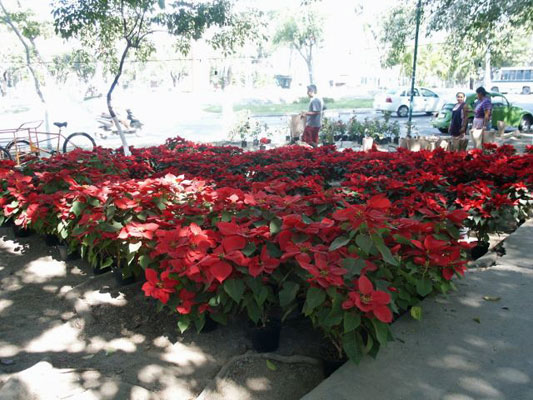
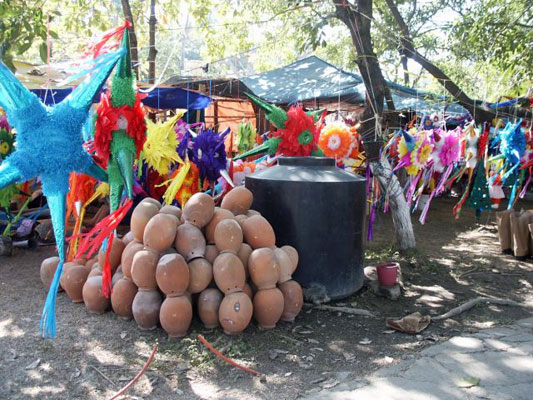
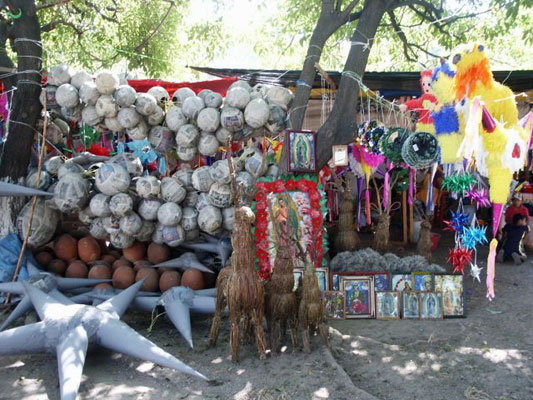
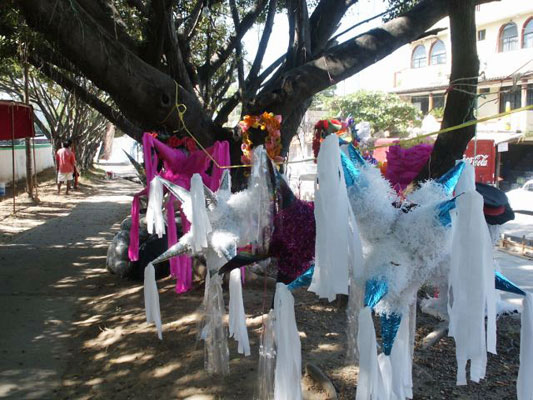
The Villas were packed full of locals from Mexico City. Ruben apologized. He explained that the Mexicans would party all night, eat and drink in Rabelaisian style. They would be noisy but I was invited. That’s when I found out about Bacalao.
It surprised me that salt cod would be the signature ingredient in a favorite traditional dish in Mexico during the Christmas season. But, it is. As it turns out, Bacalao in various forms is popular not only in Norway and other Scandinavian countries but also in much of Europe, Latin America and the Caribbean.
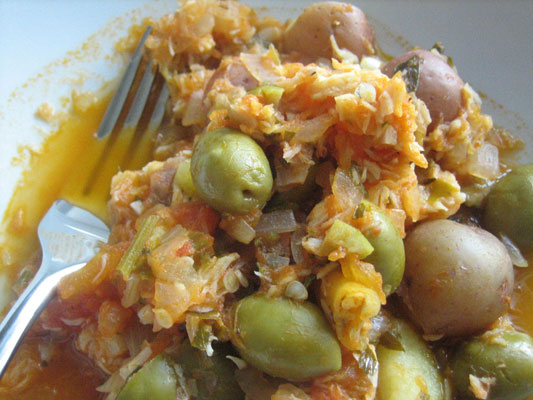
Courtesy The Mija Chronicles
I have vivid memories of that Christmas in Zihuatanejo. Ruben and Yvonne and their family, the young American restaurateurs, and Ruben’s staff were gathered around the table. The booze and wine and beer flowed. Aside from a delicious Bacalao, an unending medley of dishes appeared throughout the night. By 10 or 11 or whatever it was, I must admit I was satiated and exhausted. I begged goodnight and headed to my room. Before I ascended the stairs of my palapa, Ruben corralled me for one more drink.
“I guess you’ll be heading home yourself,” I said.
“Oh no, we go now to my parents house where my mother will prepare another dinner. We will be eating and drinking and partying all night.”
Incredulous, I walked slowly up the stairs and watched the other guests prepare for their party which went on as expected until the sun came up the next morning.
I woke up fresh and invigorated. I made a cup of coffee, sat in the open air section of the palapa, fired up my computer and started to write. Now, ten years later, the book is at the printer. The whole experience has been very satisfying.
One of the best recipes for Bacalao that I’ve found is from Lesley Tellez posted below.

Courtesy The Mija Chronicles
Christmas Bacalao
FROM: The Mija Chronicles
by Leslie Tellez
Inspired by a vendor at Mercado de la Merced, and Rick Bayless’s Mexican Kitchen
Serves 6 to 8 as a light dinner
Bacalao is sold all over Mexico City around Christmas time, and once you buy it, it keeps for up to two months, or so says the lady at Mercado de la Merced. To cook it, start preparing the day before. Place the bacalao in a dish and cover with cold water. Change out the water every few hours, until the bacalao is sufficiently less salty. You can also freeze it for a few days, if you totally lose track of time.
Also, it’s not the traditionally Mexican thing to do, but I’d serve this with a fresh green salad sprinkled with panela cheese, or any other mild fresh farmer’s cheese to contrast with the bold flavors of the fish. A big hunk of crunchy bread would go well, too.
It’s best to use the freshest, ripest tomatoes possible. Only about half of mine were truly ripe, and the dish still turned out well, but lacked a big bright punch of tomato flavor. Next time I may try slow-roasting a few tomatoes, and adding that into the mix as well.
Ingredients
1 1/2 pounds of bacalao (salted, dried cod)
1 1/2 pounds small red potatoes
2 pounds ripe tomatoes
1 large white onion, diced
3 garlic cloves, peeled and minced
1/2 cup flat-leaf parsley
3/4 cup green olives, either left whole, or pitted and sliced
6 pickled guerito chiles, or more if you like it spicy
1/2 teaspoon thyme
Prepare the cod the day before by placing it in a dish of cold water. Change out the water every few hours, until the cod no longer tastes overly salty.
If you live in a high altitude, like me, you’ll want to prepare the potatoes next, because they take forever to cook. I like to save time by zapping them in the microwave. Place them in a microwaveable bowl and toss with 1 teaspoon salt. Cover tightly with plastic wrap and cook at 5 minute intervals, on high, until they’re tender. Leave them in the microwave, covered, to keep warm.
Roast your tomatoes either under the broiler or on a comal, until they’re blackened and blistered in spots. Remove the skins once they’re cool enough to handle, and place them in a blender. Puree until you no longer see any thick pieces of tomato.
Heat a few glugs of olive oil over medium heat in a large, 12-inch skillet, or a enameled dutch oven. Add your onion and cook until softened, about five minutes. Then add garlic and cook until aromatic, about 30 seconds to a minute. Add the tomato mixture, stir, and cook the whole thing until it’s reduced and thick, about 15 to 20 minutes, depending on your altitude.
While the tomato mixture is cooking, place your newly salt-free bacalao in a sauce pan, and cover it with water. Bring to a boil, cover, and simmer the fish for about 5 minutes. Drain and set aside.
Once your tomato sauce has thickened, add the parsley, olives, guerito chiles, and thyme. [Note: The Mercado de la Merced market vendor also says to add carrots here. I didn’t have any in the house so I didn’t use them, but a touch of sweetness from the carrots would make a nice addition.] Stir in enough water to create a soupy broth, and then add your fish into the pan, nestling it inside so it’s covered by the other ingredients. Simmer for an hour, adding more water if fish looks too dry. Bayless’s recipe says the fish should break up into chunks, but mine didn’t entirely do that, and it still tasted fine.
When fish is done cooking, add your potatoes to the pot and stir. Serve in heaping spoonfuls on a plate, and garnish with parsley. Sing “Feliz Navidad” as you eat.

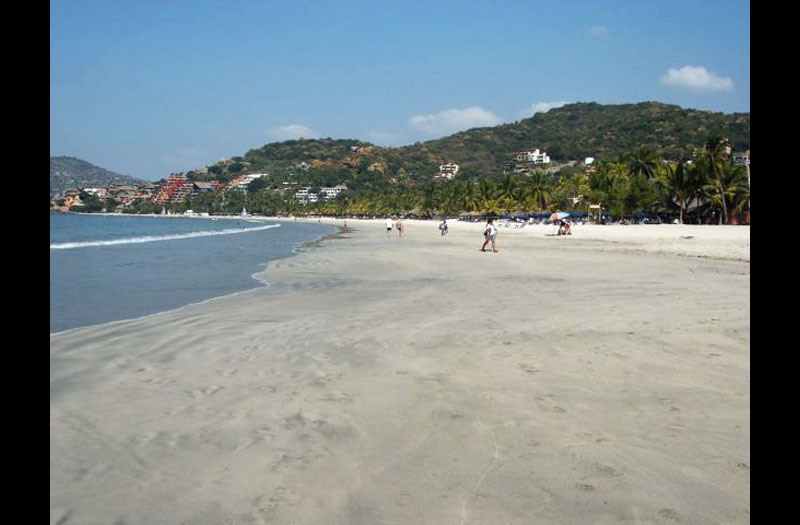
Remember us when you’re a famous author, KD…
I don’t need to be a famous author to remember my friends. Thanks Gregor.
If you love bacalao as much as I do, you must read the little book called, “Cod” by the same author who wrote “Salt” Both fascinating books. This winter I didn’t go to Mexico which is my usual habit, and I dearly miss my cousin’s Christmas in Xalapa and VeraCruz
Oh Rhoda, thank you. I will definitely read the book. I hope you get to visit your family soon. We truly enjoyed Xalapa and Vera Cruz when we were there too long ago. We hope to return someday. David